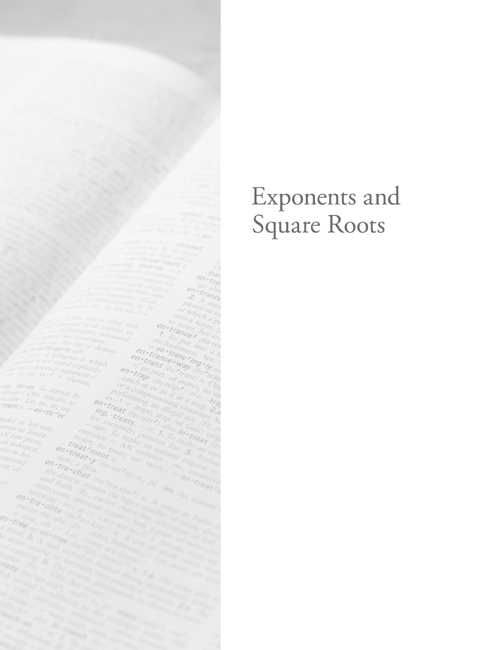
For some reason, exponents and square roots always look scary; maybe it’s the funny little symbols. ETS has a real gift for making them look challenging, but they are all based on the same set of basic rules.
If you see a2, it simply means a × a. If you see a3, it means a × a × a, and so on. Hence, the golden rule of exponents is
When in doubt, expand it out.
x2 times x3 equals x5, because
x2 · x3 = (x · x)·(x · x · x) = x2+3 = x5
When you multiply numbers raised to powers, simply add the exponents.
You can continue this logic when you are dividing exponents.
![]() equals
equals ![]() , because expanding out and canceling leaves you with only one x in the divisor.
, because expanding out and canceling leaves you with only one x in the divisor.
![]()
When you divide numbers raised to powers, simply subtract the exponents. Thus, x2–3 equals x–1 which is the same thing as ![]() .
.
This same rule applies to exponents and parentheses as well.
![]()
When you raise a number with a power to another power, simply multiply the exponents.
The one thing to remember with an exponent outside of a parenthesis is that the exponent applies to everything inside the parenthesis. Thus: ![]() and (4x)2 = 16x2.
and (4x)2 = 16x2.
If you see a problem that asks you to add or subtract large exponents, look for an opportunity to factor. This is particularly true on Quant Comp problems. Often, you don’t need to solve; you just need to make the two columns look similar.
Here’s an example:
|
Quantity A |
Quantity B |
|
|
328 |
Quantity A involves the subtraction of two large exponents. Quantity B has a large exponent suspiciously similar to the ones in Quantity A. When a question like this appears, you know two things right away. First, you will never be asked to figure out the actual value of 330. The answer to this problem will come from knowledge and manipulation, not from calculation. Second, the number in Quantity B is a clue: 328 exists in both columns. Your strategy is to isolate the information that is the same in both columns and examine the information that is different.
When large exponents are added or subtracted, look for opportunities to factor.
Start by trying to isolate the 328 in Quantity A.
Here’s what happens:
![]()
When you factor 328 out of the expression on top, you are left with 32 minus 1. This you can solve; it equals 8. Low and behold, there is an 8 on the bottom, and now you know you’re getting somewhere. The 8’s cancel out and you’re left with 328 in both columns; thus, the answer is choice (C).
Here are some other things to keep in mind about exponents.
Square roots are the same thing as exponents, but in reverse. Rather than making things exponentially larger, square roots make them exponentially smaller. There’s not much you can do with square roots. You can add them or subtract them only when the roots are the same; thus ![]() because now there are two of them. When the roots are different, though, you can’t add or subtract them.
because now there are two of them. When the roots are different, though, you can’t add or subtract them.
When you are multiplying square roots, you can combine things under a single symbol.
![]()
You can also combine when dividing.
![]()
Remember that even if the number under a square root sign is not a perfect square, it doesn’t mean that there aren’t some perfect squares in there. These you can factor out. For example, there is no even square root of 12, but 12 is a product of three and four. Three has no even square root, so it must stay under the sign. Four is a perfect square, though; you can take it out from under the sign and call it two.
![]()
Remember that ![]() means two times the square root of three.
means two times the square root of three.
There is one tricky thing about square roots: negative numbers. When you square 3, you get 9, but when you square –3, you also get 9. That means that when you’re going in the other direction, you have two possible answers. Thus, if you’re told that x2 = 9, then x = ±3. However, on the GRE, the square root of a number is defined as the positive root only, so ![]() equals 3, not ±3.
equals 3, not ±3.
A square root only has a positive solution, but an exponent to the 2nd power has both a positive and a negative solution.
For more practice and a more in-depth look at The Princeton Review math techniques, check out our student-friendly guidebook, Cracking the GRE.